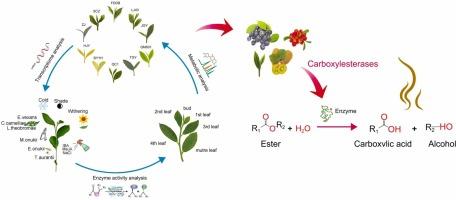A comprehensive study of carboxylesterases involved in the degradation of volatile esters in horticultural crops
IF 6.2
1区 农林科学
Q1 AGRICULTURAL ENGINEERING
引用次数: 0
Abstract
Volatile esters play a crucial role in shaping the aroma profiles and sensory attributes of horticultural crops. In this study, we comprehensively investigated the volatile esters, alcohols, and acids profiles of different tea plant varieties and tissues to identify the key metabolites responsible for tea flavors. Subsequently, two homologous genes, CXE2 and CXE3, which encode a carboxylesterase and are involved in the hydrolysis of esters, were screened from Camellia sinensis, Vaccinium darrowii, Myrica rubra, and Actinidia chinensis via multiomics analysis. In vitro, the purified recombinant enzyme CXE2 and CXE3 catalyze the hydrolysis of acetate esters into alcohols and acids. Molecular docking, site-directed mutagenesis, and enzyme activity analysis revealed that Tyr-15 and Gly-81 were the key amino acids that imparted hydrolytic activity to CsCXE2, whereas Gly-81 and Gly-82 were the key amino acids that imparted hydrolytic activity to CsCXE3. In vivo, the low expression of CsCXE2 and CsCXE3 led to decreased normal pollen and an increased presence of triangular pollen. In tender tea shoots, the results of gene silencing and withering treatments revealed that CsCXE2 and CsCXE3 disrupted acetate metabolism and altered the dynamic balance between green grassy and fruity aroma-related compounds by hydrolyzing acetate esters. Overall, this study highlights the significant potential of targeting CXE2 and CXE3 for precise flavor modulation in horticultural crop cultivation and processing, offering novel strategies to optimize the aroma profiles of horticultural crops in industrial applications.

参与园艺作物挥发性酯降解的羧酸酯酶的综合研究
挥发性酯在塑造园艺作物的香气特征和感官属性方面起着至关重要的作用。在这项研究中,我们全面研究了不同茶叶品种和组织的挥发性酯、醇和酸的特征,以确定茶味的关键代谢产物。随后,通过多组学分析从山茶、杨梅、杨梅和猕猴桃中筛选出两个编码羧酸酯酶并参与酯水解的同源基因CXE2和CXE3。在体外,纯化后的重组酶CXE2和CXE3催化醋酸酯水解成醇和酸。分子对接、定点诱变和酶活性分析表明,tir -15和Gly-81是赋予CsCXE2水解活性的关键氨基酸,而Gly-81和Gly-82是赋予CsCXE3水解活性的关键氨基酸。在体内,CsCXE2和CsCXE3的低表达导致正常花粉减少,三角花粉增加。在嫩芽中,基因沉默和枯萎处理结果表明,CsCXE2和CsCXE3通过水解乙酸酯破坏乙酸代谢,改变绿草和水果香气相关化合物之间的动态平衡。总之,本研究强调了CXE2和CXE3在园艺作物种植和加工中精确调节香味的巨大潜力,为优化园艺作物在工业应用中的香气特征提供了新的策略。
本文章由计算机程序翻译,如有差异,请以英文原文为准。
求助全文
约1分钟内获得全文
求助全文
来源期刊

Industrial Crops and Products
农林科学-农业工程
CiteScore
9.50
自引率
8.50%
发文量
1518
审稿时长
43 days
期刊介绍:
Industrial Crops and Products is an International Journal publishing academic and industrial research on industrial (defined as non-food/non-feed) crops and products. Papers concern both crop-oriented and bio-based materials from crops-oriented research, and should be of interest to an international audience, hypothesis driven, and where comparisons are made statistics performed.
 求助内容:
求助内容: 应助结果提醒方式:
应助结果提醒方式:


